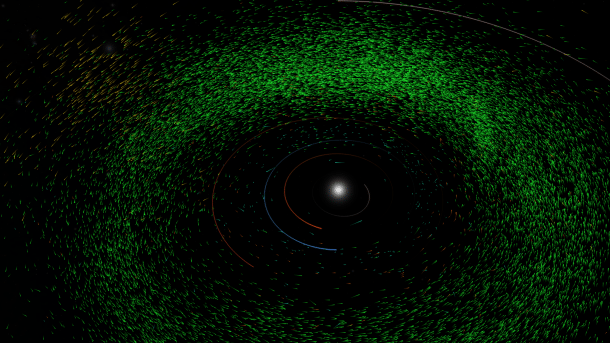Thanks to Google Cloud: algorithm finds 27,500 asteroids in old images
Without the need for a single new astronomical observation, almost 30,000 previously unknown asteroids have now been found using AI technology.
The orbits of the asteroids now discovered
(Bild: B612 Foundation)
Using AI algorithms and thanks to the resources of the Google Cloud, a research team has probably discovered 27,500 previously unknown asteroids without having to carry out a single new astronomical observation. This is reported by the US organization "B612 Foundation", which is dedicated to asteroid defense. The candidates that have now been discovered are highly likely to be genuine asteroids, but this has not yet been definitively confirmed.
The research team reports that most of the celestial bodies are located in the asteroid belt between Mars and Jupiter. However, over 100 near-Earth asteroids are also said to be among them. In total, more asteroids were discovered in the first quarter of 2024 than in the entire previous year of 2023.
(Bild: B612 Foundation)
Discovering asteroids without tracklets
According to the press release, the researchers worked with a database containing millions of astronomical images from the US research facility NOIRLab. These were uploaded to the Google Cloud and then searched by an AI algorithm called THOR (Tracklet-less Heliocentric Orbit Recovery). It correlated billions of imaged objects and searched for tracks indicating asteroids. It found what it was looking for in tens of thousands of cases, and the technology met the high expectations. In a first attempt two years ago, the algorithm had already discovered around 100 previously unknown asteroids.
Asteroids are normally discovered by photographing the same area of the sky several times over the course of a night. Celestial bodies within the solar system move on them, creating "tracklets". Based on these, data on the position and movement of the celestial bodies can be determined, which can then be further researched. The THOR algorithm now manages without such tracklets and only requires several images of a celestial region taken within a few days. To achieve this, it connects points of light that match asteroid orbits. This allows old collections to be searched for previously undetectable celestial bodies, as is now the case with NOIRLab's NSC DR2 catalog.
The technology should significantly speed up the search for asteroids once again. This has already gained enormous momentum over the past 20 years. The search is primarily for near-Earth asteroids that could pose a threat to our home planet. For the particularly large ones, our picture is already largely complete, but for the smaller ones, many unreported cases are assumed. But even objects with a diameter of a few hundred meters could cause immense devastation in the event of an impact. The THOR algorithm was developed at the Asteroid Institute of the B612 Foundation. It now wants to look for many more catalogs.
(mho)
